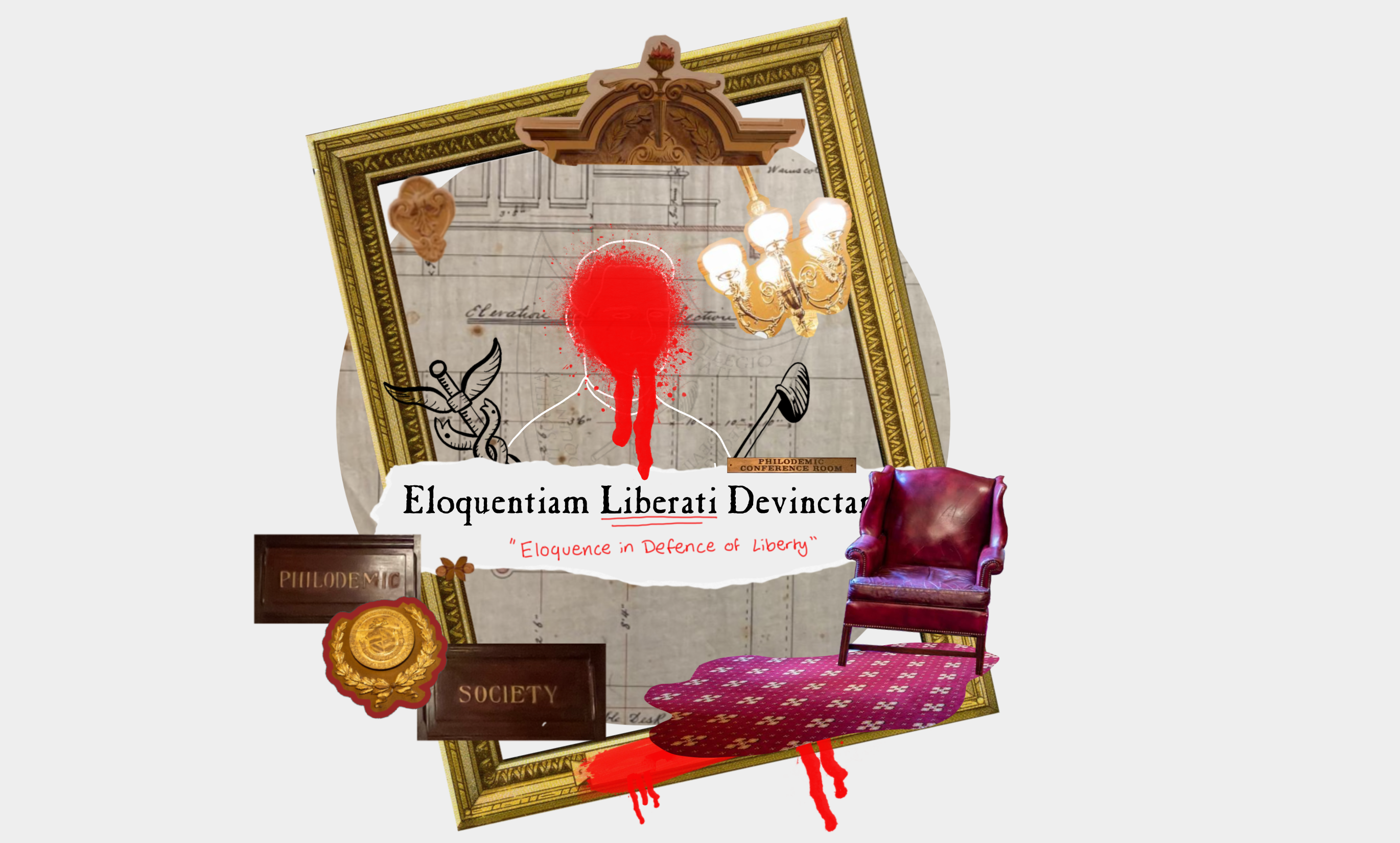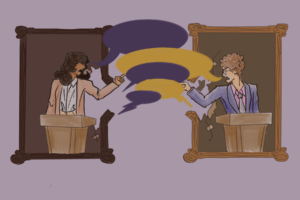Along the four long walls of the Philodemic Room in Healy Hall, there are empty spaces where portraits once hung.
The removal of portraits of historical figures this past winter break was one step in a multiyear effort from the Philodemic Society’s Committee on Slavery, Memory, and Reconciliation to come to terms with the organization’s history.
Hanging on the walls of the Philodemic Room since at least 1901 were the white faces of Confederates and Ku Klux Klan members; the names of infamous anti-abolitionists were written on the ceiling. It wasn’t until a group of Philodemicians brought these issues into the spotlight in 2018 that Georgetown considered altering the room housing Georgetown’s oldest and longest-running student organization to be more inclusive.
“A couple of friends of mine were looking around the room, and they saw on the ceiling names like John C. Calhoun,” Zachary Thompson (SFS ’20), former chair of the committee, said. “And then looking around at the portraits and who had their names written.” The students found Steven A. Douglas, who advocated in favor of keeping slavery, as well as Edward Douglas White, a Supreme Court justice who joined the Confederacy.
Inspired by campus-wide conversations about how to reckon with and rectify Georgetown’s institutional history with slavery, the Philodemic Society began an internal conversation in 2017 about the prominence given to these figures on the walls of the room and their history—a conversation that proved controversial given the strong ties some members and alumni feel to the storied room.
The society—founded in 1830 by Fr. James Ryder, S.J., an anti-abolitionist who defended slavery—holds weekly meetings in the Philodemic Room, where members debate relevant political and philosophical issues and display rhetorical skill. But for Thompson and his roommates, the room itself, and those it lionizes, became a topic of debate.
“My roommates and I started having these conversations, ‘Can we do something about this? Is this really right?’” Thompson said. “Let’s at least have a conversation with the President’s Office, because our society’s motto—Philodemic’s motto—is ‘eloquence in the defense of liberty,’ and we thought these men definitely did not represent that.”
With nearly 200 years of history, the Philodemic Society has had its share of uplifting and supporting racist ideology. “The society has always tended to debate very current social issues. And in the past the kind of sensitivity for what is acceptable to debate has just not been there,” Aida Ross (SFS ’22), Philodemic’s president in 2021, said. In the 1800s, the society frequently debated the institution of slavery and voted in favor of maintaining the system multiple times.
In fall 2017, members voted on a proposal to send a letter to the President’s Office addressing the portraits of Confederates and KKK members. While the room houses Philodemic debates, the President’s Office acquired ownership of the space in the 1990s, meaning that any renovations must be approved by the administration. The proposal to send the letter failed and was tabled with the goal of redrafting the letter.
One year later, the redrafted letter was passed by a margin of one vote in spring 2018 and sent to the President’s Office with a request to meet. A series of meetings were held between the office and the society, and in the fall, the Philodemic Committee on Slavery, Memory, and Reconciliation began its work.
The committee, chaired by Thomspon, completed its report in 2019. Its analysis included short biographies on the portraits and sorted them into four recommended categories: permanent retention, immediate removal, further research, and eventual displacement.
Ultimately, the committee recommended the immediate removal of seven portraits and four names on the ceiling. Of the 34 portraits, only four were recommended for permanent retention: Bailey K. Ashford, Frank Baker, James Hoban Sands, and Surgeon General Francis M. Gunnell.
The committee also recommended that once the portraits were removed, an empty frame be left as a reminder of the pictures that once decorated the walls, and for a plaque to be placed below it to tell the history of the room. Additionally, the report suggested that the Philodemic Society hold an annual event about the society’s history with slavery.
The President’s Office was on the whole, receptive to the Philodemic Society’s request, according to current committee chair Nile Blass (COL ’22)—but before substantial plans could be made, COVID-19 hit. They hired SmithGroup, a contracted architectural firm handling renovations, during the pandemic. In the 2021-2022 winter break, an independent contractor with art restoration and preservation experience removed the portraits. Only the portraits the society and the President’s Office agree upon preserving will be rehung on the walls. The room continues to be actively used on Thursday nights for debates, and SmithGroup is still drafting renovation plans.
“The university is committed to preserving the historical character of the space, and its identity and use as a space for Philodemic Society debates, while carefully considering how a future interpretive framework can ensure it is a welcoming and inclusive space for the entire university community,” a university spokesperson wrote in an email to the Voice.
Now, the Philodemic Committee on Slavery, Memory, and Reconciliation is working on what to do with the rest of the portraits and names. “How do we change some of the portraits that are up to both honor the work of the committee and to honor the fact that the room wasn’t always this way?” Ross said.
Recent work to make the Philodemic Society’s space more inclusive has been driven by the organization’s Philodemicians of color, such as Thompson, Ross, Blass, and Max Zhang (SFS ’23), who have all been crucial, multiyear committee members and meet with the President’s Office and SmithGroup weekly.
“It previously was a space that made a lot of students of color uncomfortable, particularly Black students, and we have a serious issue with diversity in our club,” Ross said about the club’s history as a predominantly white, male-dominated organization.
It is crucial that the portraits of racists no longer remain in the room if the society wishes to diversify its membership and be a space where students of color can feel comfortable debating ideas, according to Ross. “Not only do students not see themselves reflected on the wall, they see on the wall the veneration of people who have actively worked to harm their own people, to harm them, and to create structures of racism, inequality, and oppression that are long-lasting and are still prevalent today,” she said.
Blass, who has been the organization’s vice president twice and has won several prestigious awards within the Philodemic Society, noted that the photos on the wall no longer reflect who the society has deemed its most successful speakers.
“There is nobody that we venerate on the wall who looks like me, so I feel like we’ve evolved in such a way that our best speakers are sometimes, but not always, white men,” Blass, a Black woman, said. “It’s not even representative of who we validate as a Philodemic Society of being worth platformed and worth listening to.”
Removing portraits creates an opportunity to use the space to display the society’s current values. “It does make the room much more inclusive to have not only [the portraits] taken down but hopefully other people of color put up, to know that white people aren’t the only eloquent people,” Thompson said.
The Philodemic Society has taken steps in recent years to bring its conduct and practice into line with the values of its current members. After a Black woman faced racial discrimination at Martin’s Tavern in the Georgetown neighborhood, Philodemicians ended their tradition of French fries and French onion soup at the restaurant after debates.
The committee also hopes to make renovations to the Philodemic Room that will make it more physically accessible for all individuals.
“There’s this element of grandeur being there, but it’s not by any means an accessible space and that’s another thing that the committee is working for,” Ross said, explaining that some mobility-impaired students cannot go up the steep steps to reach the speaking dais.
To Blass, it’s important that inclusion is reflected in the renovations of the Philodemic Room. “The platform from which we speak or from where the President sits and maintains the entire debate, is that even accessible to everyone?” she said. “What are we communicating by ensuring that that’s not acceptable?”
The proposed and enacted changes, however, have met an uneven reception as some students and alumni cling to preserving the historic value and traditions of the Philodemic Room.
According to Daniel Ernst (COL ’18), president of the Alumni Philodemica, alumni are not monolithic on their position on the issue, although the general consensus seems to generally support undergraduate efforts and prioritize ensuring their access to the room.
Some alumni are very supportive of student attempts to improve the club’s inclusivity, but there are also those who want to preserve the historic and treasured space as much as possible, Ernst explained. “There are obviously alumni who would prefer to see no changes whatsoever, and there are some alumni that are very creative and want to see all sorts of changes,” he said.
“The majority of folks fall in sort of middle between those two views, where they recognize that there is a reason to take those portraits down but would love as much as possible to keep the aesthetic that they had,” he added.
Others would prefer the room remains unchanged. In February, The Hoya published a student’s opinion piece in opposition to renovations, announcing the establishment of “The Sodality for the Historic Preservation of Philodemic Hall.” The piece spoke against altering the room’s “Victorian” design. Some members of the Committee on Slavery, Memory, and Reconciliation responded by noting that the group wants to maintain the historical elements while making it accessible for all members, and further noted numerous factual inaccuracies in the piece.
“There’s always been this tension within the society and within the university of to what extent should historical preservation exist at the expense of discriminating or not being very sensitive to a lot of students and their background,” Ross said. An institution like Georgetown, which prides itself on its historical values, must give its history of slavery equal weight, according to Blass. “Georgetown just doesn’t get to have it both ways,” she said. “A lot of our ideals on which we validate ourselves as an institution, but also use to generate attention from prospective students, from prospective donors, is our history. But if that history is based in support, it’s also our responsibility to acknowledge the aspects based in marginalization and oppression.”
The onus to reckon with and rectify the society’s racist history cannot be put on the Philodemicians of color alone. To Ross, it’s important for the organization as a whole to work to improve the space and make the club more inclusive. “We’re not always going to have a woman of color as President, we’re not always going to have a majority-female board or a board of majority people of color,” Ross said. “You kind of go back a step if you have leadership that doesn’t value the work of the committee, that doesn’t value making spaces more accessible.”
But the pandemic disrupted time on campus and led to a ticking clock for progress before Philodemicians with vital institutional memory graduate. “It has kind of felt like a race against time to get some of these initial changes done,” Ross said, noting that the class of 2023 is the last group of students who were on campus working on the committee with some of its original members pre-pandemic.
Now, they hope the work continues beyond them.
The discussion and debate over respecting history and tradition, and the work from the Philodemic Society’s Committee on Slavery, Memory and Reconciliation, are a part of the larger trend on Georgetown’s campus of students pushing the university to acknowledge and act upon its own racist history, such as activism around the GU272+.
“I think if you care about history, this project should matter to you,” Blass added. “I think it’s a smaller part of a larger push to ensure that powerful institutions like Georgetown can be accountable to themselves and to the people who built them and to the people who attend them and fund them.”
Editor’s Note: Max Zhang is a member of the Philodemic Society’s Committee on Slavery, Memory, and Reconciliation and the Voice’s managing editor. Zhang was not involved in the article’s editing process.





Nicely written. I have the sense after reading this hat the racists are not the one’s on the wall. .
This article is missing the other side’s point of view. The Philodemic Hall was designed by the first Black president of a major university, who was born a slave. The Philodemic Hall stands as a monument to his desire for Georgetown to be a place for Reconciliation after the Civil War. Blue & Gray. Reconciliation requires both the victorious and the vanquished. Those portraits represent men who put the past of conflict behind them to reunite as Georgetown alumni and Philodemicans. The University is allowing the revision of history for an overreaching, privileged, entitled sojourner’s truth. It is time to say: enough.
So Mr. Thomson needed for portraits to be replaced “to know that white people aren’t the only eloquent people,” Fourth Grade must have been spectacular.
So what do we know here: The Philodemic is not inclusive, they say, and its membership has been predominantly male and white, and it has a history supporting slavery solely because debaters favored it (presumably over 150 years ago when it was still a thing) and yet these “people of color” and women have served as top officers, chaired a key committee and won top debating distinctions. Something just doesn’t seem honest here. With a DEI welcome and achievements like these one might be better off with more white men on the wall.
They are proud, That is nice. Guys, it is only a room, and from the looks of it had no connection to slavery except some debates and few segregationists on the walls. have you been to the Capitol. Now that you know that DeGioia goes for this, Show some real courage and go after the Carroll statue. This Room is nothing. It helps only to show that white guilt will get you anything you demand and link to slavery. Go for the prize.
The Voice might have taken the time, unlike President DeGioia’s office, to check the veracity of the the claims made by the solipsists who glorify themselves in these 2000 words. Of all 34 plus men they supposed researched only one was alleged to be in the KKK, but that is based only on self-serving rumor. It is, however, amply proven otherwise by common sense and reason. Chief Justice Edward Douglas White was the least likely Klansman. He was highly educated, did not trumpet his likely Confederate service as a teenager, he was from a scion family, a lawyer and A DEVOUT CATHOLIC!!!! The Klan wanted to keep the Black man down, but they hated the Papists, especially Catholics in public office. They blamed Catholics for everything that was wrong. These kids don’t care about history, they care about their ability to fool gullible people.
In point of fact, the SmithGroup, the researchers hired by the University, after studying the biographies corresponding to all 34 photographic portraits in the Philodemic Hall (as well as the oils) found that not one was a member of the KKK. Not one. Boo The Georgetown Voice for falling for this racist scam.